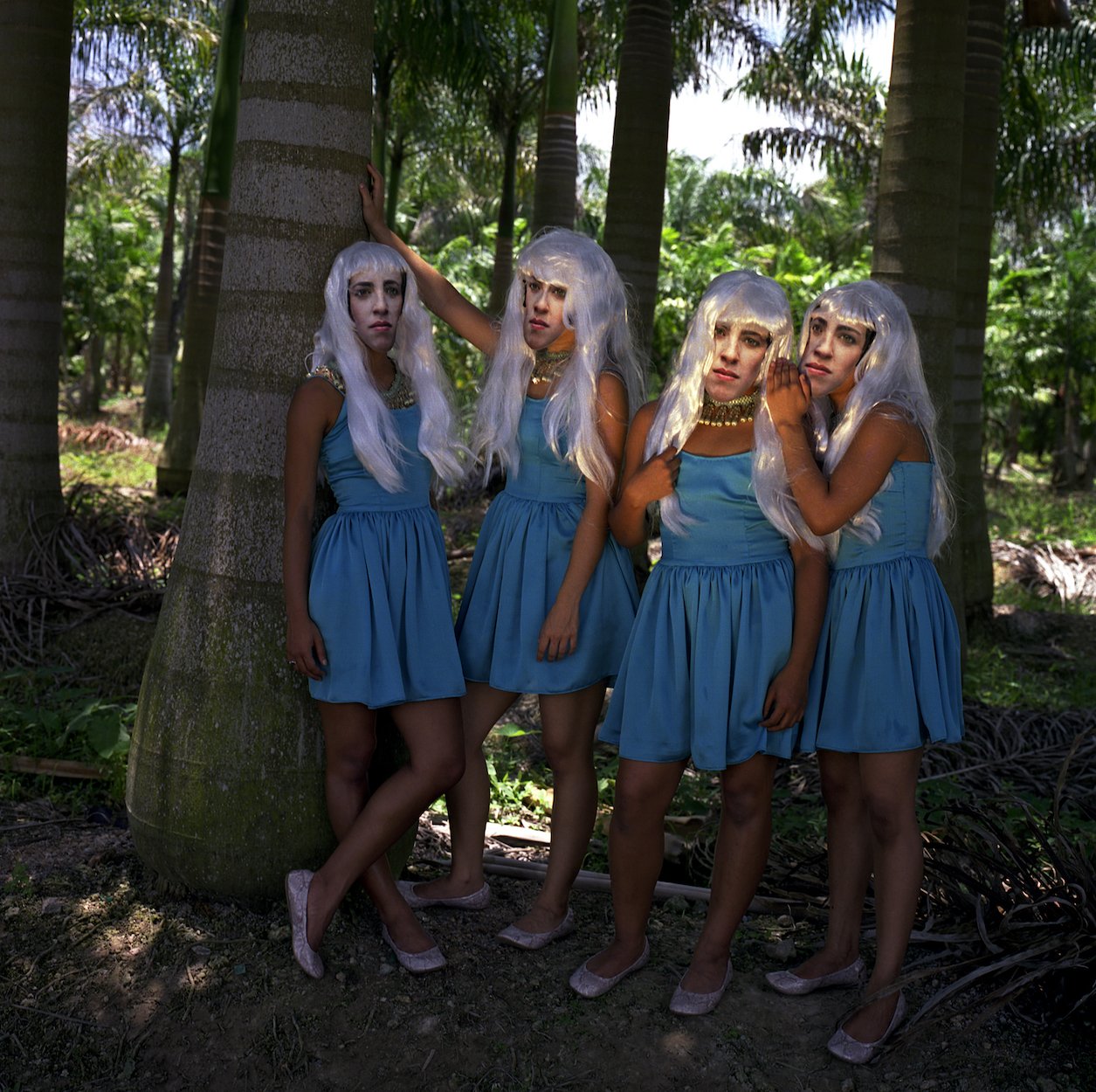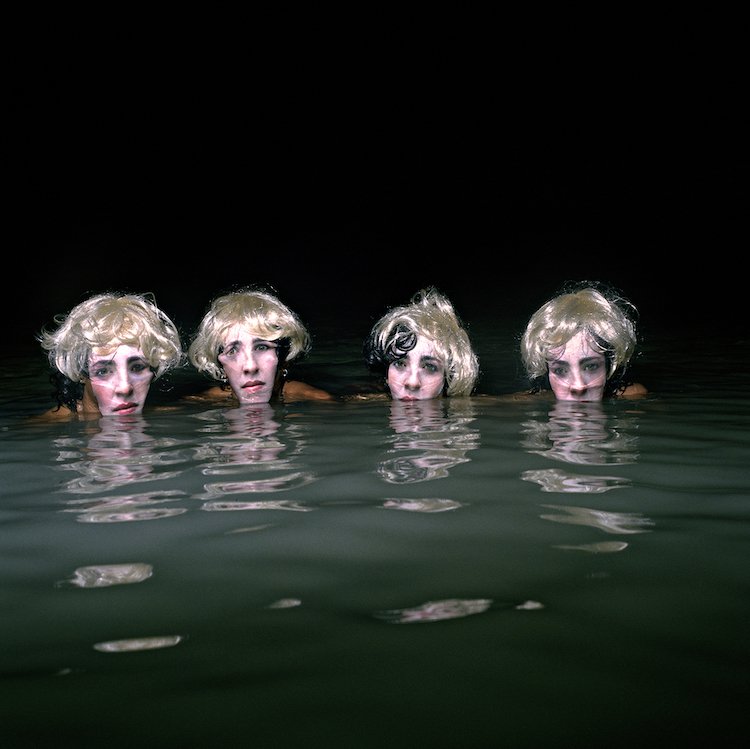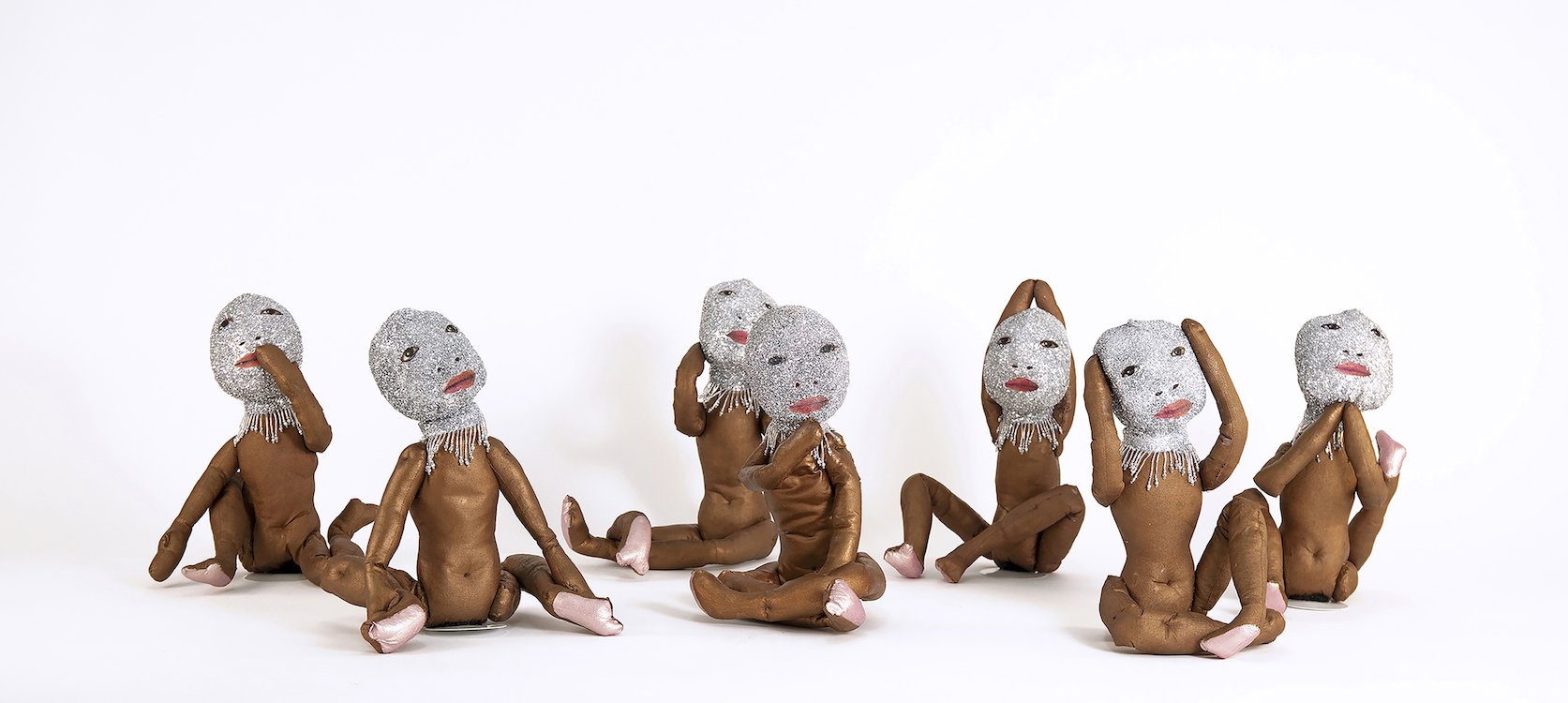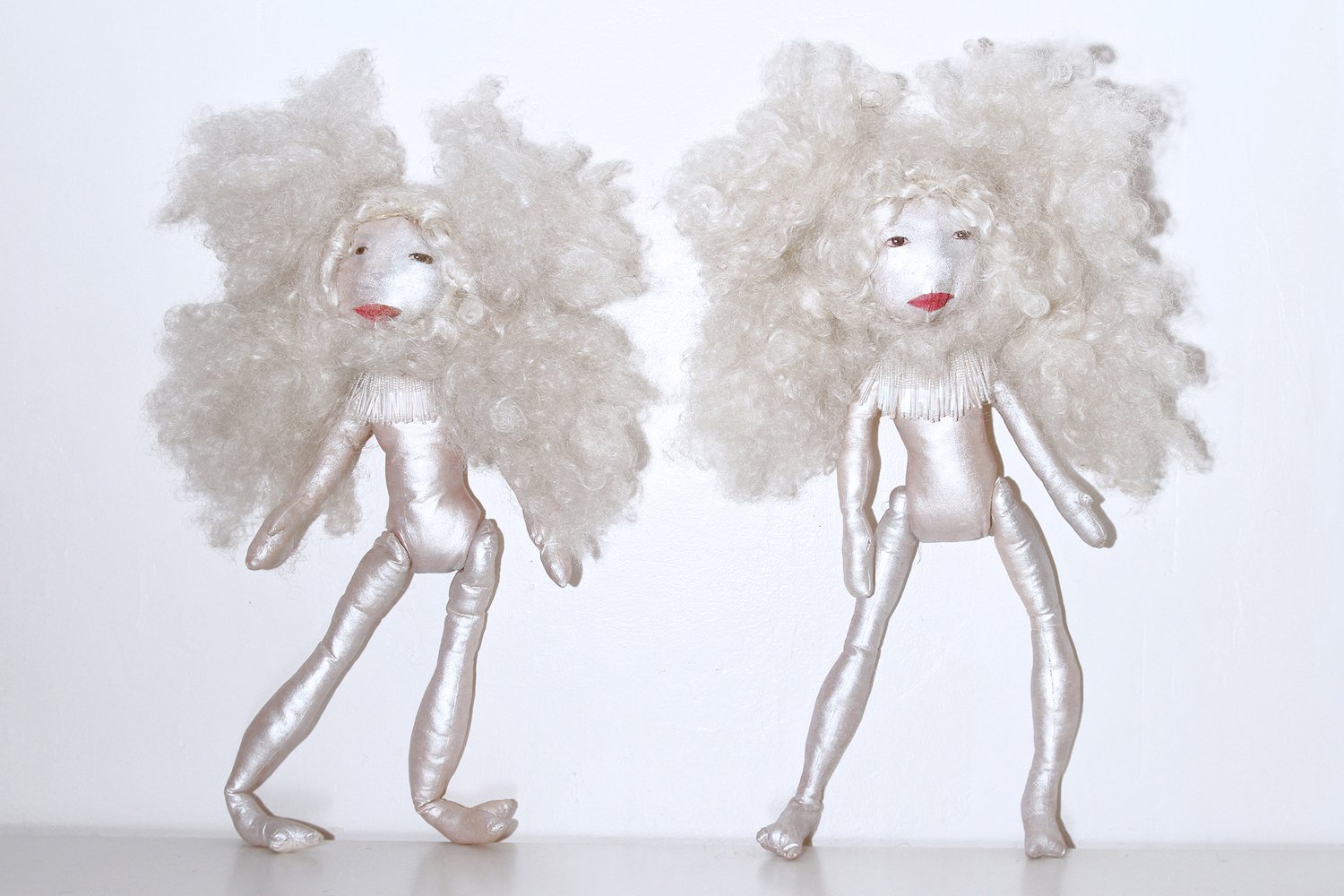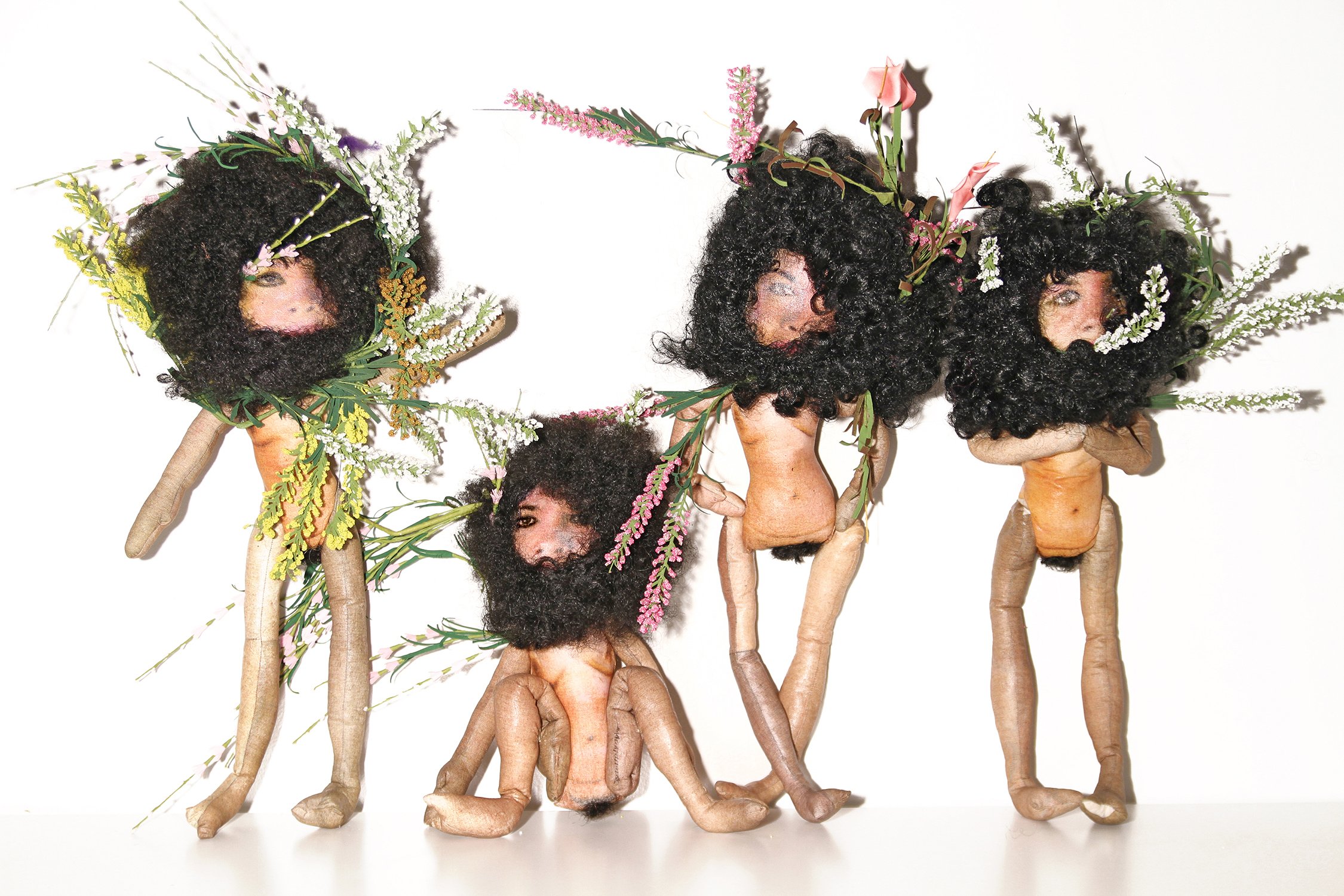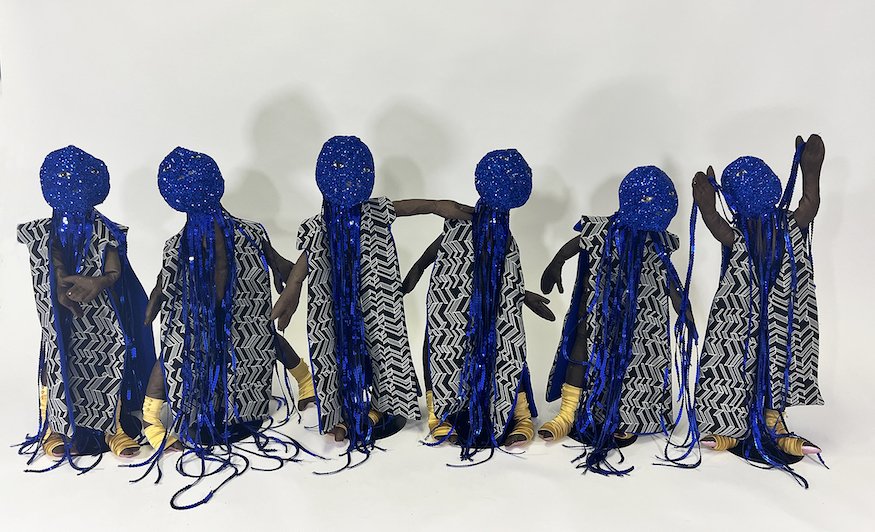Elia Alba
Nicolás Dumit Estévez Raful Espejo: Elia, I feel that this conversation is long due, at least in written form. I am saying this because we have discussed some of these points before, but never put them down on paper. Can we concentrate on your work on dolls? What set this in motion?
Elia Alba: It started when I was pregnant with my son in the late 1990s. In preparing his room for his arrival, I wanted to decorate it with images of diverse children. Rather than painting them on the wall, I created about sixty small rag dolls, with different skin tones, colored hair and clothing that were hung so they would appear holding hands and they wrapped around his room on the wall to create a border. It was important to me for my son to view difference in his toys and environment.
My doll-making was further propelled by the advent of the Bratz dolls in 2001. They came out when I was in my late 30s and I was completely fascinated. I started collecting them and currently have over 100. The “girls with a passion for fashion” was their motto, and they were a diverse group which was shockingly new at the time, but ideologically not too far from what I was thinking when I created those dolls for my son’s room.
As a child of the ’60s and ’70s, I grew up with Barbie dolls that didn’t reflect who I was. Of course, at such a young age I never thought about it in those terms, but as I think back it certainly made me question my own sense of beauty and how I viewed myself. When Bratz came around, they completely disrupted the industry at the time when Barbie was the norm. For me, they spoke to what kids actually wanted, not what their parents felt like they should want. Bratz dolls were different, they came out and reflected an urban identity that had not been seen before, an identity that has influenced music and fashion to this day. While the Bratz have evolved into a more iconic type of phenomena, that initial fascination and impact has stayed with me.
It wasn’t until 2010 that I made my first doll. The early ones were nude and to some degree grotesque, a push back, if you will, against certain beauty standards that are inherent in dolls, including the Bratz. As I moved further into doll-making, I wanted to create dolls that imbue a deeper understanding of diasporic identities. Dolls have been a significant part of material culture for centuries, dating back to ancient civilizations. They are often seen as more than just toys, as they can hold cultural and historical significance, and can represent different eras and sociopolitical movements. Within this framework, I wanted to create dolls that highlight hidden histories and mythologies of diasporic people. The current dolls do not reference a specific group of people but rather are an amalgamation of identities and histories. They are meant to be recognizable yet, at the same time, undefinable, to create a sense of wonder and curiosity.
NDERE: The focus of the Q&Is that are part of Be my Guest is healing, so I will be moving swiftly in this direction. Similarly, I am personally interested in creative processes that leave behind very little or no footprint at all, ecologically speaking. However, one part of me is fascinated by objects and artifacts which retain the energy of the process. Your dolls seem to fall in this realm. Is this correct? If so, can you talk about this?
EA: Dolls can definitely hold a special kind of energy through our imagination and emotions. When we play with dolls, we bring them to life with our thoughts and feelings, giving them their own unique energy. In the case of my dolls, they are all made with my likeness. I think it’s my footprint I leave behind with them – how I see myself and the stories I want to share. I see parts of myself in each of those dolls. It comes from my Caribbean upbringing, especially from the Dominican Republic, where there is still shame in being too dark or too ethnic presenting. Those dolls highlight the beauty and knowledge of the ancestors and I choose, through the doll, to be the conduit for that information and understanding.
NDERE: I come from the Caribbean where things like hair strands and nail clippings are not items one comfortably share. Before the whole social media thing, some people there were also cautious about sharing personal photographs. All of these items can carry the energy of the person. In your work you use images of friends and people in your immediate communities. Why so? And how might this speak about trust, relationships, and the like?
EA: When I started creating dolls, I made a choice not to use any one’s face but my own. One thing is to photograph a person, and another is to make them into a doll. There is a part of me that believes that dolls represent individuals and not sure I want, as you say “carry the energy of that person.” And the flip side to that is the responsibility and care that one has to assume for that other person’s energy.
NDERE: In one of my visits to the Cementerio de la 30 de Marzo in Santiago, Dominican Republic, I recall going from grave to grave to see offerings, and I was surprised by what I found. In one of the niches, a family member of the departed had cut out a photo of the person and dressed this as a doll. Now that I revisit this memory, it reminds me of your aesthetics. You were raised both in the Caribbean and in New York City. How would you say these back and forth journeys might have influenced what you do?
EA: When I think of my work overall, it is that liminal space that I am most interested in. In the natural world, the concept of in-betweenness is often associated with transitional spaces, such as the area between land and sea or the space between light and shadow. But really for me, these are places of transformation and renewal, where new forms and ideas can emerge. In human relationships, the concept of in-betweenness can be seen in the space between individuals or groups with different beliefs, values, or identities. This space can be a site of conflict and tension, but it can also be a place of exchange and dialogue, where new understandings and connections can be formed. In a cultural context, the concept of in-betweenness is often associated with hybridity and the blending of different cultural forms and traditions. The Caribbean is one big liminal space! The photograph series Pixies (2009) and Danu (2012), precursors for the dolls, as well as the dolls themselves are about that in-betweenness, that fluidity and complexity of the world around us, emphasizing the ways in which different things are interconnected and constantly in a state of transformation. “These ‘in-between’ spaces provide the terrain for elaborating strategies of selfhood—singular or communal—that initiate new signs of identity, and innovative sites of collaboration, and contestation, in the act of defining the idea of society itself.” [1]
NDERE: In another one of my incursions into the cities of the dead in the Dominican Republic, I was guided to a grave, whose proprietor was still alive. The woman in question had assembled a considerable collection of dolls (as far as I can remember, all of them white-skinned ones) in her mausoleum. This comment can take us in many directions. But let’s focus on the subject of dolls as it pertains to colonization and decolonization of mind-body-spirit. I am listening to you.
EA: Dolls have been often used as a tool of colonialism to impose Western values and culture on black and indigenous bodies. For example, European colonizers would bring dolls to Native American communities as a way to assimilate children into Western culture and discourage their traditional ways of life. Further, mass-produced toys of all kinds had begun to enter American homes around the turn of the century, and many of them exploited racist tropes and dolls were no exception. It wasn’t until the early 1980s that non-white dolls began to appear, but it was very gradual. However, there has been a movement in the last 20 years or so to create dolls that represent diverse cultures and identities, as a way to empower marginalized communities, promote cultural pride. and challenge the dominant narrative imposed by colonialism. It is within this space that I create the dolls. Also, the dolls that consider forgotten histories and mythologies that form part of who we are as diasporic people, even if we are not consciously aware. Making dolls of any kind that go against the dominant narrative is a decolonizing project.
NDERE: I had a very dear friend who was in an intensive care unit at a Manhattan hospital for several months. A neighbor made a doll that resembled her, then hid it under my friend’s mattress at the hospital. When my friend recovered, her neighbor collected the doll from under the mattress and threw this into a cemetery in Washington Heights. I bet you do not get to talk about these things in the Art world (my use of cap for Art). But at the Interior Beauty Salon, almost anything goes! Can you share about the making of your dolls, which I know you do by hand, and what emerges for you energetically?
EA: The dolls are made through a photo transfer process on fabric. The doll parts, legs, arms, torso and head, are sewn with a machine, but the body parts are then assembled by hand. Clothing and adornments can be done by machine or by hand. I recently began using roving wool and felting the dolls’ hair. What’s fascinating about the process of felting is that it is an ancient craft that dates back as far as 6th Century BCE. Some of the oldest pieces of felt have been found in tombs and burial grounds in Siberia, Scandinavia, and Germany. It involves using wool fibers to create dense matted fabric by applying heat, moisture, or pressure.
How a doll is “born” or conceptualized depends on what I am reading. For example, the myth of the Moongazer appears in different variations throughout the Caribbean. In all the stories, the Moongazer is a very tall man with very long legs, who habitually gazes at the full moon. He can be found standing straddling a road or on the edges of a cliff staring at the moon, and he also can cause death to those that cross his path. However, in Guyanese folklore, he mostly roams the shorelines staring at the moon as he walks and many believe that the Moongazer tale was birthed to keep island children away from the shorelines. The Moongazers I created are female and have a welcoming look about them unlike their male counterpart. They have white hair and white pearlized bodies with painted lips. When I was creating these dolls, I was considering the Guyanese tale of the Moongazer as a female protector, as she watched over the children against the shorelines, which in colonial times, what is menacing is not just the waters but the unwanted men who arrived on the shores of the island.
NDERE: Dolls and gender are inextricably connected. I am personally into dolls, for many of the reasons that I have been stating. I find them fascinating and also an entry point into deep discussions. I have one of your dolls at my home, which is in my dining room, and that I might be moving to the Salon’s Shrine. How would you say this whole gender thing might play in terms of audiences for your work? I can be a wacky guy, so you would not have any issues with me and dolls, but that might not be the case with other people identified as men and with maleness. This is more of an invitation for you to go on about this subject.
EA: The dolls are meant to be genderless. At first glance, the dolls appear precious, yet their bearded faces and fluid bodies imply something else. Also, they have pubic hair, a small bush, so you don’t know if they are “packing” or not. Since my earlier works, I have always been concerned with fluidity, especially when thinking about my own identity, culturally and racially. I have always thought of gender as part of that conversation. In the work If I were a… (2003), body suits of my distorted figure, that you wore and performed in, was addressing gender fluidity, as was the video performance La Jaba (2003), again another video performance in which you collaborated with me. The gender manifests itself through the clothes, hair etc. However, in some cases it’s not clearly apparent. The genderless dolls allow the viewer to see what they want to see. I never point it out.
NDERE: Friend and mentor Linda Mary Montano has made dolls depicting Madonnas. I am fortunate to have one of them at The Shrine. This one is the Madonna of the Shoe. Have your spiritualities informed your doll-making?
EA: Yes, but not through ideas of Christianity but through mythologies, oral histories and other forms of spirituality. For example, The Nommodolls reference the mythologies of the Dogon, a tribe in Mali. According to their oral history, the Nommo were a race of people that lived on a planet that orbited the star Sirius A. They visited the earth 1000s of years ago and were described as being amphibious and genderless, similar creatures appear in Babylonian, Acadian and Sumerian myths. The first Nommo transformed itself into 4 twins, with one rebelling and later killed by the sky god Amma to restore order to the earth. The legend goes that the Nommo furnished the Dogon's with the knowledge about the solar system, which is not visible to the naked eye.
NDERE: I invite you to close this Q&I in any way that you see fit. Wait! can we have one of your dolls deliver the goodbye message? I thank you for being part of this conversation.
EA: How wonderful that you say this. I feel they have a secret life of their own, hence why dolls are made in pairs or groups, they cannot exist alone. Their message to you “Thank you for making space for us to exist in the world.”
[1] Homi K. Bhabha, The Location of Culture (New York: Routledge, 2004), page 2.
All photos courtesy of Elia Alba
Elia Alba / links : Website / Instagram / Facebook / The Supper Club
Elia Alba was born in Brooklyn to parents who immigrated from the Dominican Republic in the 1950s. She is a multidisciplinary artist, whose practice is concerned with the social and political complexity of race, identity and the collective community. She received her Bachelor of Arts from Hunter College in 1994 and completed the Whitney Museum Independent Study Program in 2001. She has exhibited throughout the United States and abroad. Those include the Studio Museum in Harlem, El Museo del Barrio, Stedelijk Museum, Amsterdam; Science Museum, London; Smithsonian Museum of Art, El Museo del Barrio, National Museum of Art, Reina Sofía, Madrid. Awards include the Studio Museum in Harlem Artist-in Residence Program 1999; Pollock-Krasner Foundation Grant 2002; Joan Mitchell Foundation Grant 2002 and 2008; Anonymous Was A Woman Award 2019; Latinx Artist Fellowship 2021. Collections include the Smithsonian Museum of Art, El Museo del Barrio, Lowe Art Museum. Her work has been reviewed in the New York Times, Art Forum, ArtNews, Forbes, to name a few. She was part of the curatorial team for El Museo del Barrio’s critically acclaimed exhibition, Estamos Bien: La Trienal 20/21. Her book, Elia Alba, The Supper Club (Hirmer 2019) brings together artists, scholars and performers of diasporic cultures, through photography, food and dialogue to examine race and culture in the United States. She lives and works in the Bronx.
